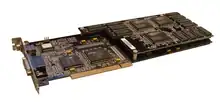
Scan-Line Interleave (SLI) is a multi-GPU method developed by 3dfx for linking two (or more) video cards or chips together to produce a single output. It is an application of parallel processing for computer graphics, meant to increase the processing power available for graphics.
3dfx's SLI technology was first introduced in 1998 with the Voodoo2 line of graphics accelerators. The original Voodoo Graphics card and the VSA-100 were also SLI-capable, however in the case of the former it was only used in arcades[1][2] and professional applications.
NVIDIA reintroduced the SLI acronym in 2004 as Scalable Link Interface. NVIDIA's SLI, compared to 3dfx's SLI, is modernized to use graphics cards interfaced over the PCI Express bus.
Function

3dfx's SLI design was the first attempt, in the consumer PC market, at combining the rendering power of two video cards. The two 3dfx cards were connected by a small ribbon cable inside the PC. This cable shared graphics and synchronization information between the cards. Each 3dfx card rendered alternating horizontal lines of pixels composing a frame.
See also
- Scalable Link Interface - Nvidia
- AMD CrossFireX - AMD
References
- ↑ Bennett, Phil. "Magic the Gathering: Armageddon - MAME preliminary driver". MAME GitHub repository. Archived from the original on December 5, 2023. Retrieved December 5, 2023.
- ↑ Ondrejka, Cory (April 5, 2019). "CoryOndrejka on: The 3dfx Voodoo1". Hacker News. Archived from the original on December 5, 2023. Retrieved December 5, 2023.
